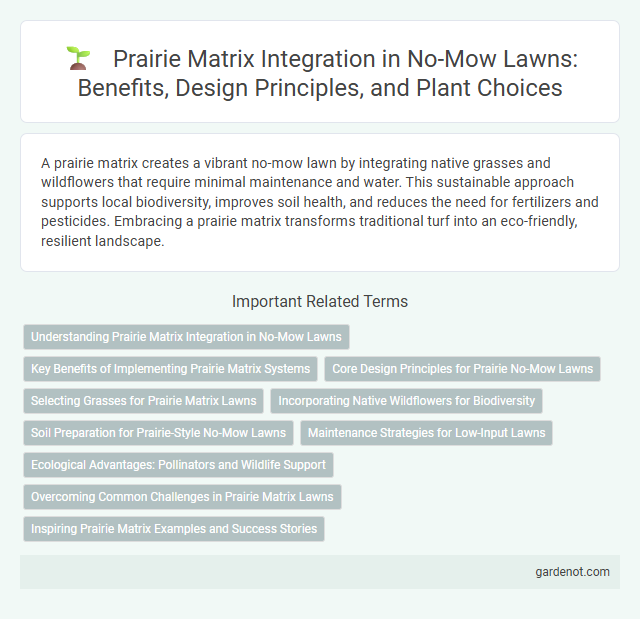A prairie matrix creates a vibrant no-mow lawn by integrating native grasses and wildflowers that require minimal maintenance and water. This sustainable approach supports local biodiversity, improves soil health, and reduces the need for fertilizers and pesticides. Embracing a prairie matrix transforms traditional turf into an eco-friendly, resilient landscape.
Understanding Prairie Matrix Integration in No-Mow Lawns
Prairie Matrix(tm) offers a sustainable solution for no-mow lawns by combining native wildflowers and grasses that require minimal maintenance. This biodiverse seed mix enhances soil health, supports pollinators, and reduces water consumption compared to traditional turfgrass. Integrating Prairie Matrix(tm) in no-mow lawns creates resilient landscapes that promote ecological balance and aesthetic appeal year-round.
Key Benefits of Implementing Prairie Matrix Systems
Prairie Matrix systems promote biodiversity by integrating native wildflowers and grasses, creating resilient habitats that attract pollinators and beneficial insects. These low-maintenance landscapes reduce water usage by up to 50% compared to traditional lawns, minimizing irrigation needs while enhancing soil health through deep root systems. Implementing Prairie Matrix systems also lowers carbon footprints by reducing mowing frequency and gasoline consumption, contributing to sustainable urban green spaces.
Core Design Principles for Prairie No-Mow Lawns
Prairie matrix no-mow lawns emphasize ecological balance by integrating native prairie plants that require minimal maintenance and promote biodiversity. Core design principles include selecting deep-rooted species for soil health, arranging diverse plant groups to support pollinators, and minimizing turfgrass to reduce water and fertilizer use. This sustainable approach enhances habitat resilience and creates a self-sustaining lawn that thrives with little human intervention.
Selecting Grasses for Prairie Matrix Lawns
Selecting grasses for prairie matrix lawns involves choosing native species like little bluestem (Schizachyrium scoparium), switchgrass (Panicum virgatum), and big bluestem (Andropogon gerardii) that offer drought tolerance and adaptability. These warm-season grasses create dense root systems that improve soil structure, reduce erosion, and require minimal mowing. Integrating diverse native grasses supports pollinators and enhances the ecological resilience of prairie matrix no-mow lawns.
Incorporating Native Wildflowers for Biodiversity
Incorporating native wildflowers into a prairie matrix enhances biodiversity by providing essential habitats and food sources for pollinators like bees and butterflies. These wildflowers support soil health through symbiotic relationships with mycorrhizal fungi, promoting nutrient cycling and water retention. Integrating a diverse range of native species ensures resilience against pests and environmental stressors, creating a sustainable no-mow lawn ecosystem.
Soil Preparation for Prairie-Style No-Mow Lawns
Soil preparation for prairie-style no-mow lawns involves deep tilling to improve aeration and drainage while incorporating organic matter such as compost to enhance fertility and microbial activity. Achieving a balanced pH between 6.0 and 7.0 supports native prairie grasses like Little Bluestem and Prairie Dropseed, promoting robust root systems that reduce erosion. Proper soil preparation reduces weed competition and ensures long-term sustainability of low-maintenance prairie matrices.
Maintenance Strategies for Low-Input Lawns
Prairie matrix lawns thrive with minimal mowing by using native grasses and wildflowers adapted to local climates, reducing water and fertilizer needs. Implementing seasonal mowing schedules aligned with plant growth cycles fosters biodiversity and suppresses invasive species naturally. Strategic maintenance, including spot weeding and mulch application, enhances soil health and sustains low-input, eco-friendly landscapes.
Ecological Advantages: Pollinators and Wildlife Support
Prairie matrix no-mow lawns enhance biodiversity by providing essential habitats and nectar sources for pollinators such as bees and butterflies. Native grasses and wildflowers improve soil health, reduce erosion, and support a wide range of wildlife, including birds and beneficial insects. This sustainable landscaping approach contributes to ecosystem resilience by maintaining natural plant communities and promoting environmental balance.
Overcoming Common Challenges in Prairie Matrix Lawns
Prairie Matrix lawns excel in drought tolerance and native biodiversity, yet common challenges include weed invasion and uneven establishment. Effective seedbed preparation and annual overseeding promote dense cover, while selective herbicide use targets invasive species without harming natives. Proper maintenance involving timely mowing and irrigation adjustments ensures a resilient, low-maintenance prairie lawn.
Inspiring Prairie Matrix Examples and Success Stories
Prairie Matrix showcases transformative no-mow lawn designs that blend native grasses and wildflowers for sustainable landscapes requiring minimal maintenance. Successful installations across urban and suburban settings highlight increased biodiversity, reduced water usage, and enhanced soil health as key environmental benefits. These inspiring examples demonstrate how Prairie Matrix creates resilient, low-maintenance lawns that support pollinators and reduce carbon footprints effectively.
Prairie matrix Infographic

 gardenot.com
gardenot.com